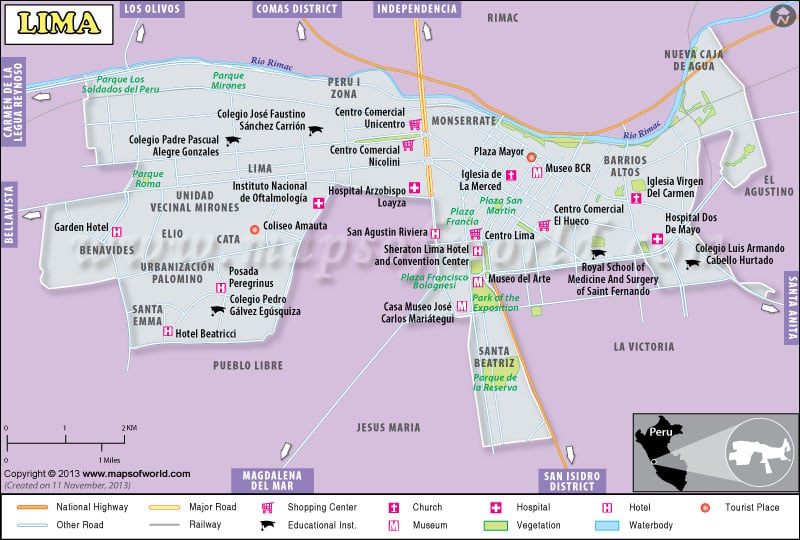About city
Lima is the capital of the South American country of Peru as well as its largest city. It covers an area of 2,672.3 sq km and had an approximate population of 7,605,742 in 2007.
It forms a part of the largest metropolitan area of Peru.
The area occupied by Lima was originally inhabited by several Amerindian groups under the Incas in the 15th century. In 1532, the last Inca emperor Atahualpa was conquered and killed by the Spanish conquistadors, led by Francisco Pizarro. Pizarro was made the Governor by the Spanish King and he established his capital on the site of present day Lima in 1835 and named it Ciudad de los Reyes. This area was known as Limaq in the local language. So, the new capital city soon came to be known as Lima. When Peru became independent, Lima became its capital.
Geography
The city of Lima is located on the dry desert plain that lies between the arid Peru coast and the Pacific cliffs to the west and the foothills of the Andes to the east. The urban area has grown up on the flat plains of the Rivers Chillon, Rimac, and Lurin. The city slopes gently upwards to a height of 500 mts. Several isolated hills are scattered throughout the city. The San Cristobal Hill in the Rimac District in Lima is the most extreme outgrowth of the Andes.
The city enjoys a mild subtropical climate. It is located in the desert, but the shores are washed by cold currents which modify the weather. Summers are warm, humid, and sunny. Winters are cooler and often covered by foggy and overcast skies. Rainfall is very low, but heavy mist called Garua is common.
How to reach (transport)
You can travel to Lima in the following ways:
- The Jorge Chávez International Airport is located in Callao, which forms a part of the Lima Metropolitan Area. Regular flights are available to select destinations of North and South America and Europe.
- Several buses ply on the Pan-American Highway connecting Lima with several domestic destinations. There are two major bus termini in the city. Apart from these, most companies maintain their personal terminals.
When to visit
The best time to visit Lima is in the summer, when the weather is dry and bright. Winters should be avoided as the sky tends to be foggy and overcast. Culture (fairs and festivals) and traditions
Several fairs and festivals are celebrated throughout the year in Lima. Some of them are as follows:
- The anniversary of the city is celebrated on 18th January with a huge parade called Pasacalles. Folk music, dances, and artistic performances are held throughout the city.
- The Independence of Peru is celebrated from 27th to 29th July throughout Peru. Festivities are also observed in Lima. A big military parade is held and sports events, concerts, and theatrical shows are common on this day.
- The Procession of the Lord of Miracles is the largest of its kind in South America. It is celebrated in October or November. The origin of the festival can be found in colonial times when an African slave drew the picture of a Black Christ. It could not be removed in spite of many attempts and heavy earthquakes. Today, it draws tens of thousands of believers, who carry the image in a huge litter in a 24-hour procession from Church Las Nazarenas to Church La Merced.
- The Feria Taurino is the annual bullfight event that takes place every Sunday in October and November in Lima.
Points of interest (places to visit)
Some of the most important landmarks of Lima are as follows :
- Lima Cathedral lies on the land designated as the first church of Peru by Pizarro. It comes with a baroque facade and it has been restored several times.
- The Plaza de Armas, marked by an impressive bronze fountain used to be the heart of the original city.
- The Museo Larco contains one of the best displays of ceramics in Lima.
- The Museo de la Nacion provides insight into the rich history of Peru.
- The Pachacamac is a complex comprising archeological sites, including a pre Columbian citadel lying about 38 kms from the city. It has been an important religious center for more than 2000 years. The citadel is home to houses, palaces, and temple complexes.
Accommodation
Lima offers a wide variety of accommodations but it is in general, an expensive city. The 5-star hotels include Miraflores Park and Sheraton Lima, while numerous 4-star hotels include the Swissotel, JW Marriott, and Country Club Lima. The 3-star hotels include the Duo, Continental, Kamana, Bayview, Esperanza, and Senorial. The 2-star hotels work well for those traveling on a budget and include La Posada del Parque and D’osma – Bed & Breakfast.

 Tacna Map
Tacna Map